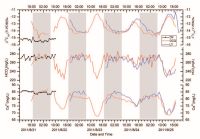Diel cycling and flux of HCO3− in a typical karst spring-fed stream of southwestern China
DOI:
https://doi.org/10.3986/ac.v45i2.4045Ključne besede:
inorganic carbon cycle, spring-fed stream, aquatic vegetation photosynthesis, CO2 degassing, inorganic carbon flux, karstPovzetek
We investigated the diel variations of the dissolved inorganic carbon, isotopic composition, and partial CO2 pressure from a karst spring (Guangcun Village, Guangxi, Southwest China) to the 1,350 m downstream profile of the stream. In addition, the carbon loss and CO2 exchange flux at the water-gas interface were also estimated. The results showed that the pH value and DO in the stream varied regularly on a daily basis with the temperature of stream water, suggesting that the photosynthesis of aquatic plants and algae is the controlling factor for the diel variations of the pH and DO. During the monitoring period, while the DIC (mainly in HCO3−) input (at spring) was relatively stable at about 4.46 mmol L−1, the concentrations of HCO3− and Ca2+ at downstream showed a diel cycle of daytime decrease and nighttime increase, with an amplitude of 22.4 %. We also found out that the CO2 degassing mainly occurred in the upper reach of the surface stream right after groundwater is exposed to the surface. The total CO2 exchange flux of the entire monitoring stream section was calculated to be 29.83 kg d−1, accounting for 17.8 % of the DIC loss, which means that approximately 4/5 of the loss was converted into organic carbon or calcite precipitation. Compared with the total carbon input at spring, this carbon loss only accounts for 6.5 % of the total carbon amount (1.4 % of which was converted into organic carbon and 1.1 % of which was degassed to the atmosphere), indicating that the DIC of karst groundwater in low order surface stream of Guancun is stable in general, with 1 % being lost to the atmosphere. This suggests that on a daily timescale, carbon loss in the form of CO2 of low order karst streams with lower gradient is much less pronounced.
Key words: inorganic carbon cycle, spring-fed stream, aquatic vegetation photosynthesis, CO2 degassing, inorganic carbon flux, karst.
Prenosi

Prenosi
Objavljeno
Kako citirati
Številka
Rubrike
Licenca
Avtorji jamčijo, da je delo njihova avtorska stvaritev, da v njem niso kršene avtorske pravice tretjih oseb ali kake druge pravice. V primeru zahtevkov tretjih oseb se avtorji zavezujejo, da bodo varovali interese založnika ter da bodo povrnili morebitno škodo.
Podrobneje v rubriki: Prispevki




